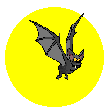Extension Activities

* The Organization for Bat Conservation has a program that allows your class to adopt-a-bat. This program helps orphaned and injured bats and is funded by individuals at a cost of $15 per year. After adopting a bat, the class will receive a picture of the bat and a personal letter of thanks from the bat. They will also send you an information sheet on the species of bat you adopted and a huge full color bat poster.* * For more information go online to The Organization for Bat Conservation
and another Organization for Bat Conservation
Math* Discuss the different types of bats the children will be able to adopt and make a chart using the spreadsheet and chart application of a word processing program.
* Students vote on what type of bat they want to adopt and keep a tally of the votes; students can use a database application.
* Students make a bar graph with the outcome of the vote using Microsoft Works/Spreadsheet/Chart.
* Students come up three questions about their graph.
Science
* Students will go online to Bat's Body and by clicking on the parts of the bat's body, the child can read what it does.
* Students will compare the body parts of the bat with that of the human body and make a list of common parts.
* Students will ask clarifying questions about the bat and human anatomy. Photo of bat skeleton included in the student activity.
* Students can also use a Venn Diagram to help them see more clearly the similarities and differences between themselves and bats. Students will go online to Venn Diagram to look at the graphic organizer that will help the children see more clearly the similarities and the differences between a bat and a human body.
* Students can pick a bat and research the following information and put it on a chart.
Bat Name What it Eats Where It Lives Interesting Facts
* Students will complete the following activity above by opening a word processing and inserting a table with four columns and one row (or choose four columns), then type the following headings in each column: Bat Name, What it Eats, Where it Lives and Interesting Facts.Language Arts
* Students complete a story evaluation on Stellaluna.
* Students participate in a fun writing activity by creating a book similar to the main characters in Stellaluna but using different animals, such as a fish and a dolphin. In order to make the story accurate, the students will have to research those animals to find their similarities and differences.
* Students can use various search engines to collect information on their animal such as: Google, Yahooligans, FactMonster and AskJeeves.
* Students can use Print Shop to make a pamphlet on Bats with the following information:
1) List three facts about bats.
2) List three myths about bats.
3) New words I learned
4) What was the most interesting thing you learned about bats?
5) Why are bats important? List three things.
6) Do you like bats? Why or why not?
7) List any other information you would like to tell about your bat.
8) Download a picture of your bat and its habitat.
* At a Learning Center, you can have questions that the students have to answer when they are finished with their work.
Art
* Students can go online to find directions on how to make a Bat Mobile, Bat Flying Flip Book or Bat Clips at Bat Projects and Activities
